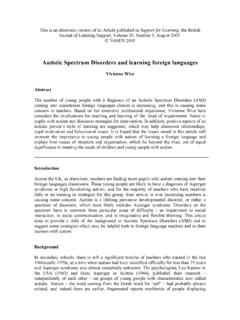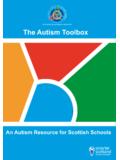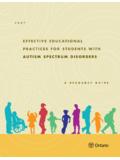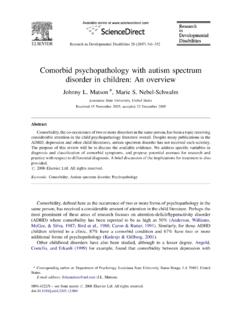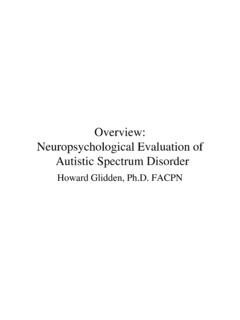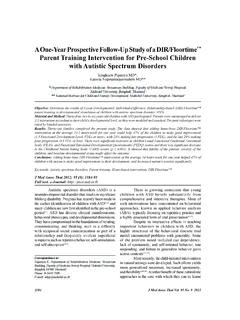Transcription of QEEG characteristics and spectrum weighted frequency for ...
1 Pop-Jordanova et al. Nonlinear Biomedical Physics 2010, 4:4. RESEARCH Open Access qeeg characteristics and spectrum weighted frequency for children diagnosed as autistic spectrum disorder Nada Pop-Jordanova*, Tatjana Zorcec, Aneta Demerdzieva, Zoran Gucev Abstract Background: autistic spectrum disorders are a group of neurological and developmental disorders associated with social, communication, sensory, behavioral and cognitive impairments, as well as restricted, repetitive patterns of behavior, activities, or interests. The aim of this study was a) to analyze qeeg findings of autistic patients and to compare the results with data base; and b) to introduce the calculation of spectrum weighted frequency (brain rate) as an indicator of general mental arousal in these patients.
2 Results: Results for Q-EEG shows generally increased delta-theta activity in frontal region of the brain. Changes in qeeg pattern appeared to be in a non-linear correlation with maturational processes. Brain rate measured in CZ shows slow brain activity (5. 86) which is significantly lower than normal and corre- sponds to low general mental arousal. Recent research has shown that autistic disorders have as their basis disturbances of neural connectivity. Neuro- feedback seems capable of remediating such disturbances when these data are considered as part of treatment planning. Conclusions: Prognosis of this pervasive disorder depends on the intellectual abilities: the better intellectual functioning, the possibilities for life adaptation are higher qeeg shows generally increased delta-theta activity in frontal region of the brain which is related to poor cognitive abilities.
3 Brain rate measured in CZ shows slow brain activity related to under arousal. Pharmacotherapy combined with behavior therapy, social support and especially neurofeedback technique promise slight improvements Background and scientific interest worldwide. Main clinical signs of autistic spectrum disorders are a group of neurological autism as described by Kanner and Asperger in the for- and developmental disorders associated with social, ties of the last century are still not changed [1-7]. communication, sensory, behavioral and cognitive The broad variation in phenotypes and severities impairments, as well as restricted, repetitive patterns of within autism spectrum disorders suggests the involve- behavior, activities, or interests. autistic spectrum disor- ment of multiple predisposing factors, interacting in ders (ASD) include autism, pervasive developmental dis- complex ways with normal developmental courses and order and Asperger's.
4 These are life-changing, family- gradients. ASD is generally accepted as the most genetic altering conditions usually diagnosed in early childhood. of all the developmental neuropsychiatric syndromes. In recent years, this group of impairment has shown a However, despite more than several decades of genetic dramatic increase in prevalence, which raises the clinical study, the precise etiology of ASD still remains unknown, largely due to the genetic and phenotypic diversity, or heterogeneity of this disorder, and the lack * Correspondence: Pediatric Clinic, Faculty of Medicine, University of Skopje, Macedonia of biologically based classification systems [8-10]. 2010 Pop-Jordanova et al; licensee BioMed Central Ltd. This is an Open Access article distributed under the terms of the Creative Commons Attribution License ( ), which permits unrestricted use, distribution, and reproduction in any medium, provided the original work is properly cited.
5 Pop-Jordanova et al. Nonlinear Biomedical Physics 2010, 4:4 Page 2 of 7. Review of some major textbooks on ASD and of have registered the incidence about 1:300 of children papers published between 1961 and 2003 yields convin- treated at the Department for Psychophysiology (the cing evidence for multiple interacting genetic factors as total number of patients is about 900 per year). the main causative determinants of autism [11-13]. The aim of this study was a) to analyze qeeg findings Epidemiologic studies indicate that environmental fac- of autistic patients and to compare the results with data tors such as toxic exposures, teratogens, perinatal insults, base; and b) to introduce the calculation of spectrum and prenatal infections such as rubella and cytomegalo- weighted frequency - brain rate parameter as an indica- virus account only for few cases.
6 These studies fail to tor of general mental arousal in these patients. confirm that immunizations with the measles-mumps- rubella vaccine are responsible for the surge in autism. Methodology Epilepsy, the medical condition most highly asso- The diagnosis is made according two statistic manuals ciated with ASD, has equally complex genetic/no (DMS-IV-R and ICD-10). In addition, we applied Aut- genetic (but mostly unknown) causes. autistic symp- ism Diagnostic Observation Schedule (ADOS) compris- toms are frequent in tuberous sclerosis complex and ing observations evaluating language, behavior, and fragile syndrome, but these disorders account for a development, some neurological tests, and structured small minority of cases. Currently, diagnosable medical interviews with parents.
7 Conditions, cytogenetic abnormalities, and single-gene Medical history, neuropsychological assessment, bio- defects ( tuberous sclerosis complex, fragile syn- chemical analysis as well as MRI have been realized in drome, and other rare diseases) together account for all children. Finally, the blood sample for precise genetic <10% of cases [14]. assessment is transported to a specific UK laboratory ASD discussed in this article corresponds to pervasive (results are still unavailable). developmental disorder (PDD) of the Diagnostic and Quantitative electroencephalographic ( qeeg ) evalua- Statistical Manual of Mental Disorders, fourth revised tion or mapping is an assessment instrument designed edition (DSM-IV) and International Classification of to pinpoint anomalies in brain function [20-25].
8 qeeg . Diseases, tenth revision (ICD-10) [15,16]. As mentioned, maps, collected using 19 electrodes based on the Inter- as ASD we mean the wide spectrum of developmental national 10-20 system, are quantitative analyses of EEG. disorders characterized by impairments in three beha- characteristics of frequency , amplitude and coherence vioral domains: 1) social interaction; 2) language, com- during various conditions or tasks. These data were munication, and imaginative play; and 3) range of than statistically compared to an age-matched normative interests and activities. database to reveal a profile of abnormalities [26]. Most pediatricians will have children with this disor- On the Figure 1 main general characteristics of brain der in their practices. They must suspect ASD expedi- mapping together with z-scores in autistic child is dis- tiously before 17 th months of life and diagnosed it played.
9 It is clear that absolute power for delta and around the third year, because that early intervention theta are increased, but also the power of beta waves increases its effectiveness. due to high anxiety can be increased in some cases. It is An astonishing 556% reported increase in pediatric very important to know that generally, alpha brain prevalence between 1991 and 1997, a prevalence higher waves are positively related to cortical information pro- than that of spina bifida, cancer, or Down syndrome, is cessing cognitive abilities. Alpha and theta brain probably attributable to heightened awareness and chan- waves change with age in a non-linear and opposite ging diagnostic criteria rather than to new environmen- way. Children with neurological and developmental dis- tal influences [17].
10 Orders such as ASD show significantly more delta and A review of prevalence survey research across the Uni- theta but less alpha power which correspond with their ted States and the United Kingdom reported rates of cognitive impairment [27]. ASD substantially increased from prior surveys indicat- ing 5 to 10 per 10,000 children to as high as 50 to 80 Results and discussion per 10,000 (equivalent to a range of 1 in 200 to 1 in 125 (1) qeeg spectra children with ASD) [18]. Another review of research on The sample comprised 9 autistic children. The mean age the epidemiology of autism [courchesne19,] indicated of our patients when qeeg was recorded was 4,92 years that approximately 60 per 10,000 children (equivalent to 1,37; while the mean age when diagnosed was 3,5.)

